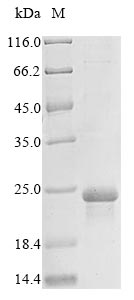Enhance your cancer research efforts with our Recombinant Human EGFR protein, a crucial cell surface receptor tyrosine kinase with vital roles in cell proliferation, differentiation, and survival. Known as the epidermal growth factor receptor, it is closely linked to multiple cancers, making it a prime target for in-depth investigation.
This Recombinant Human EGFR protein is expressed in an E.coli system, featuring a partial protein sequence (669-684aa) for focused studies. With both N-terminal 10xHis-SUMO and C-terminal Myc tags, this recombinant protein allows for straightforward purification and detection. The purity of this protein is greater than 85% as determined by SDS-PAGE, ensuring you receive a high-quality product for your research needs. Choose from liquid or lyophilized powder formats to best accommodate your laboratory requirements and optimize your workflow.






